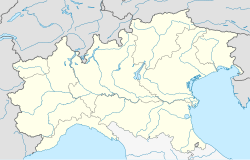 | ||||||||||||||||
| General information | ||||||||||||||||
| Location | Piazza San Babila, Milan | |||||||||||||||
| Coordinates | 45°28′00″N9°11′51″E / 45.46667°N 9.19750°E | |||||||||||||||
| Owned by | Azienda Trasporti Milanesi | |||||||||||||||
| Platforms | 4 | |||||||||||||||
| Tracks | 4 | |||||||||||||||
| Construction | ||||||||||||||||
| Structure type | Underground | |||||||||||||||
| Accessible | y | |||||||||||||||
| Other information | ||||||||||||||||
| Fare zone | STIBM: Mi1 [1] | |||||||||||||||
| History | ||||||||||||||||
| Opened | 1 November 1964 | |||||||||||||||
| Services | ||||||||||||||||
| ||||||||||||||||
| ||||||||||||||||
San Babila is an underground station on Line 1 and Line 4 of the Milan Metro. It opened on 1 November 1964 as part of the inaugural section of the Metro, between Sesto Marelli and Lotto. [2]
The station is located at Piazza San Babila, in the city centre of Milan.



